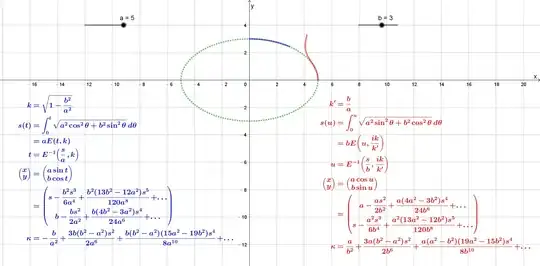Precisely the the theory of Elliptic integrals was developed to calculate this arc length. There are no closed form for this arc length in terms of elementary functions, we need especial functions.
Recall the coordinates at any point on the ellipse:
$$ \frac{x^2}{a^2} + \frac{y^2}{b^2} = 1 \tag{1} $$
Parametrically:
$$ x = a\sin^2 \varphi, \quad y = b\cos^2\varphi$$
Hence
$$ \sin^2 \varphi + \cos^2 \varphi = 1$$
Hence if $s$ is the perimeter of the ellipse, and if $b^2 = a^2(1-e^2)$ where $e$ is the eccentricity
Then
$$s = 4\int_{0}^{\frac{\pi}{2}} \sqrt{a^2\cos^2\varphi + b^2\sin^2 \varphi}d\varphi = 4a \underbrace{\int_{0}^{\frac{\pi}{2}}\sqrt{1-e^2\sin^2\varphi}d\varphi}_{E}$$
The integral $E$ is an especial function called the complete elliptic integral of the second kind:
$$ E(k) = \int_{0}^{\frac{\pi}{2}} \sqrt{1-k^2\sin^2\theta}d\theta$$
where $k$ is called the modulus
Therefore
$$ s = 4aE(e)$$
The values of $E(k)$ can be calculated numerically or from tables
For example,
$$e = 0 \Longrightarrow E(e) = \frac{\pi}{2}, \quad s = 2\pi a$$
$$e = \frac{1}{2} \Longrightarrow E(e) = 1.467..., \quad s= 5.87a$$
Update:
Following suggestions of other readers we add more theory:
One way of writing the coordinates of any point of the ellipse (1) in parametric form is
$$ x = a\operatorname{sn} u\; \quad y = b\operatorname{cn} u $$
where $\operatorname{sn}$ and $\operatorname{cn}$ are the Jacobi theta functions which have the following relations
$$ u = F(k,\phi) = \int_{0}^{\phi} \frac{1}{\sqrt{1-k^2\sin^2 \theta}} d\theta $$
$$E(u) = E(k,\theta) = \int_{0}^{\phi} \sqrt{1-k^2\sin^2 \theta}$$
$0<k<1, \quad k'= \sqrt{1-k^2}$ are called the modulus and the complementary modulus
where this integrals are the incomplete Elliptic integral of the first and second kind, respectively
$\phi = \operatorname{am} u$ is called the amplitude
$\sin \phi = \sin(\operatorname{am} u) = \operatorname{sn} u $ is called sine-amplitude
$\cos \phi = \cos(\operatorname{am} u) = \operatorname{cn} u$ is called cosine-amplitude
$\Delta\phi =\operatorname{dn}u = \sqrt{1-k^2\sin^2 \phi}$ is called delta-amplitude
Can be proven geometrically that if $B=(0,b^2)$ and $P=(x,y)$ is a point in the ellipse with $x>0,y>0$ the arc-lenght $s$ from $B$ to $P$ is given by:
$$s = a\int_{0}^{u} \sqrt{\operatorname{cn}^2u\operatorname{dn}^2u + k'^2\operatorname{sn}^2 u \operatorname{dn}^2u} du = a\int_{0}^{u} \sqrt{\operatorname{cn}^2u\operatorname{dn}^2u + k'^2\operatorname{sn}^2 u \operatorname{dn}^2u} du = a\int_{0}^{u} \operatorname{dn}u \sqrt{\operatorname{cn}^2 u +k'^2\operatorname{sn}^2u} du = a\int_{0}^{u}\operatorname{dn}^2 u du = a\int_{0}^{\phi} \sqrt{1-e^2\sin^2 \theta}d\theta $$
Now we have all the ingredients to find $s$ the arc-lenght and to find the amplitude $\phi$ in terms of the inverse of the Jacobi theta functions
A nice reference for this is Elliptic functions with applications by Bowman.
